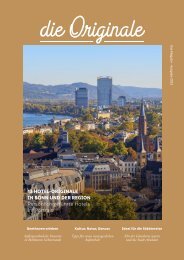LUXAIR_LUXiClub_So12 ls
p o
p
o
You also want an ePaper? Increase the reach of your titles
YUMPU automatically turns print PDFs into web optimized ePapers that Google loves.
Number 43, Fall 2002
cartographic perspectives 31
Figure 8. An image with halftones oriented in the direction of gradient of gray values
(From Sloan and Wang (1992) with permission from SPIE).
choose locally different ordered dithers based on measures of local variations
in values of gray (see Figure 8). Their rationale is that this method
provides “an extra channel that we can use to convey information about
the image” (149).
A more difficult problem is orienting halftones base on three dimensional
(3D) geometries in virtual scenes. Sloan and Wang’s (1992) research
begins with a grayscale image, devoid of information on the 3D geometry
captured in the image. Saito and Takahashi (1990) began with a 3D computer
graphics model and stored orientation information in a series of
geometric buffers (g-buffers). Information on many different geometric
components of a virtual scene is often stored in this manner. This method
was modified by Haeberli (1990) to orient the pattern of brushstrokes for
virtual 3D scenes. Veryovka and Buchanan (1999) used g-buffers to orient
halftones on an image of a 3D model based on its geometry. Haeberli
(1990) and Veryovka and Buchanan (1999) used complex raytracing algorithms
to define the geometry of the objects in the virtual scene.
The method outlined in this paper includes geometric information
derived from a 2.5 dimensional surface, one in which each grid cell has a
unique z-value. A hillshaded image can contain multiple grid cells of one
shade of gray that represent any or all aspect directions. An example is a
map of a conical hill under vertical illumination. The entire hill would be
shaded with the same tone of gray. With a constant gray value, no pattern
would be added to this hillshaded image with Sloan and Wang’s (1992)
method. The only geometric information needed to orient halftones to
create patterns similar to hachure maps is the aspect of each grid cell. The
methodology for creating such maps is described below.
This project computes hillshading from DEMs and reclassifies the resulting
256 shades of gray into 16 equal interval classes. Aspect is calculated
from the same DEMs and the resulting 360 degrees of aspect values
“Haeberli and Veryovka and
Buchanan used complex
raytracing algorithms to define
the geometry of the objects in
the virtual scene.”
“The only geometric
information needed to orient
halftones to create patterns
similar to hachure maps is the
aspect of each grid cell.”















